 Leading Blog | Posts by Month |
 Leading Blog | Posts by Month |
03.31.24

LeadershipNow 140: March 2024 Compilation
See more on
Posted by Michael McKinney at 09:34 AM
03.28.24

Leading Thoughts for March 28, 2024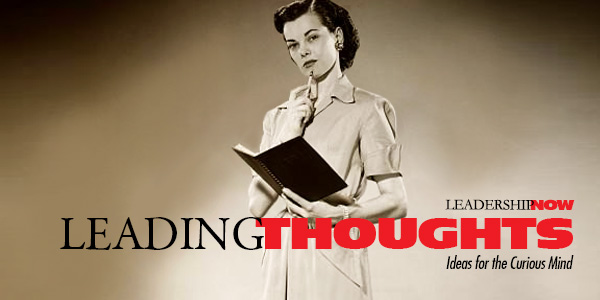
IDEAS shared have the power to expand perspectives, change thinking, and move lives. Here are two ideas for the curious mind to engage with: Executive coach Daniel Harkavy on the core coaching competency of discernment: “Discernment refers to the ability to see what is not visible, to understand what is not being said. Discernment enables a coach to ask effective questions, unearthing roadblocks, fears, and doubts that keep a team member from reaching his or her goals. And where do you get discernment? It comes with time in the coach’s seat. The more you invest in people and the more focused and intentional you become about helping people overcome obstacles, the more you will develop your discernment muscle.” Source: Becoming a Coaching Leader: The Proven System for Building Your Own Team of Champions Pete Davis on democracy and commitment: “In many ways, our whole democracy is an exercise in intertwining commitments and change. Democracy is all about the institutionalization of constant change. Even at the smallest level of democracy—a simple political conversation with someone with whom you disagree—we need commitment. Both people have to come to the table in good faith. If you’re not committed to a deliberative process, it has no chance of transforming you. A conversation you can easily exit is one where there will be none of the reconciliation, transformation, discovery of commonality, or higher synthesis—none of the development of a shared culture—needed to make democracy work. In a democracy, we’re working on something together, so the tension that comes with association must be held by everyone. If there’s no commitment to that tension, there can be no democracy.” Source: Dedicated: The Case for Commitment in an Age of Infinite Browsing Look for these ideas every Thursday on the Leading Blog. Find more ideas on the LeadingThoughts index.
Posted by Michael McKinney at 08:28 AM
03.26.24

Ten Principles to Keep Our Anger in Check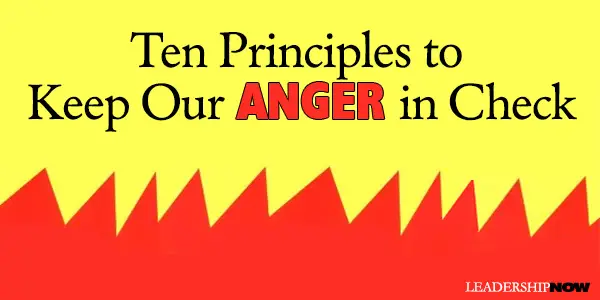
ANGER comes down to a distortion of the self in relation to the world. It is the distorted view that we are the arbitrators of truth and justice. Anger assumes privilege. Anger exercised gives us a jolt of temporary superiority. It is fair to say that there is often much at work and the world at large to legitimately get angry about—when things are not working as we think they should. Anger always seems to be waiting in the wings. Our anger is too often out of proportion—that is to say, out of context—because our sense of self looms large. Not all anger is bad, but if we don’t deal with it appropriately, it will sap our conviction to do anything positive to improve the situation. Anger can alert us to take positive, constructive action when we keep it in check, slow down, and think. Anger is a choice we make. In Why Is Everyone So Cranky: The Ten Trends Complicating Our Lives and What We Can Do About Them, author Leslie Charles provides us with ten principles to keep our anger in check: 1. Live with purpose. Have a sense of who you are and what your life stands for. Connect your sense of purpose with your everyday behavior to keep your life meaningful and congruent. 2. Enhance your self-awareness. Stay focused on your purpose. 3. Quit judging others. Take the energy you put into criticizing, judging, or sniping at others and channel it toward behaviors you can actually do something about: your own. Give up trying to mind other people’s business and focus on what you need to do so you can become the person you want to be. 4. Capitalize on your innate wisdom. Trust what you know and start practicing the good habits and healthy behaviors that will enhance your existence. 5. Make conscious choices. Recognize when you’ve made the choice to get upset or angry. Although you can credit someone else for being the source of your bad mood, you’re the one who’s picked up the baton. Accept that you’re really not a victim of circumstances; you’re the victim of a poor choice: letting someone else ruin your mood. 6. Think of yourself as a winner in the game of life: celebrate the positives. Study the negatives so you can prevent their recurrence. 7. Surround yourself with support. Spend your time with people who care about you, like to hear about your successes, and openly allow you to share your “boast moments.” 8. Replace negative emotions with positive ones. Quit worrying about trivial matters or running your life by fear. Assume good news unless you know better. If it’s bad news, accept, adapt, or take what you consider to be the most appropriate action. 9. Stay connected. Invest in your relationships; enrich them. Yet people you care about know they’re important in your life through acts of appreciation. Be generous with compliments. 10. Choose compassion over crankiness. Instead of getting mad at some ill-mannered person who treats you rudely, think about how miserable he or she must be; think about what it would feel like to be that person at that moment. If we assume the best in people—positive intent—we would circumvent a lot of anger. 
Posted by Michael McKinney at 10:52 AM
03.22.24

End Game First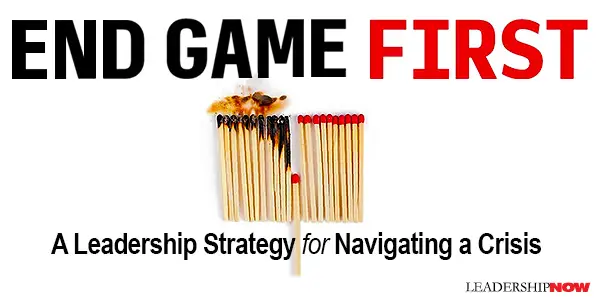
A CRISIS most often comes when you expect it least. How do you deal with the damage and move forward? Vice Admiral Mike LeFever and Roderick Jones state in End Game First, “In a crisis, you have to consider your end game first. At some point in the future, you will be out of danger and back in the day-to-day. Where do you want to be when that happens?” The end game is your exit strategy. It’s not the end of the crisis, it’s where you want to be after the crisis. It is the result of the actions you take instead of letting the crisis lead you. The end game is about how you will actively shape the outcome. There is risk with any decision made during a crisis, but it is better than standing still. If you don’t identify and act in accordance with the end game, you’re going to be caught unaware when the world moves on without you. The authors identify the four phases of any crisis—a dynamic but predictable path: Phase 1: 911 The opening moments of a crisis require immediate action—most often reactionary action. And that’s normal. But at some point, you will need to step back and observe what is happening so you can develop your strategic end game plan. Once the 911 moment begins, you’ll find yourself reacting any number of challenges. This is when you need to trust your instincts, and your preparations, as you endure the initial chaos. Even with proper planning, this can be a difficult phase. Motions run high, teams grow anxious, and unpredictable turns can come at any time. Information is a powerful currency. In the first phase of a crisis, you need to distinguish between information (raw) and intelligence (analyzed) and to take all new information with a grain of salt. Discordant information abounds in chaos. Phase 2: 2nd and 3rd Order Effects Once the chaos ends, it’s time to address the second and third-order effects. Phase 2 is characterized by moving from reacting to acting—a recovery mindset. A key characteristic of Phase 2 is that none of these solutions are permanent. You are making decisions that move you forward, but they are not the final word on the situation. As a leader, you need to realize when a fix is actually just a bandage. Some solutions also bring new problems. That’s part and parcel for this phase of a crisis. The decisions you make as a leader might plug one leak while creating another. You can’t get discouraged by cascading events, but you need to be aware that can happen. Phase 3: Steady State You’re not out of the crisis yet. “The steady state can lull you into a sense of routine, but you can’t lose focus. You can still make decisions and take actions that move you toward your end goals.” Phase 3 is a steady state of being, but it is not a sustainable environment. Or rather, it can’t be a self-sustainable environment. Steady state is marked by reestablishing some semblance of routine that allows some degree of reset. Phase 4: Reestablishing Normalcy In this phase, you recognize that the crisis is over based on the reality of the situation and dismantle the emergency infrastructure. Exiting a crisis means returning to a changed world. No matter how much you may want it to, life isn’t just going to go back to the way it was. Following a disaster, people change. Priorities change. Infrastructure changes. That’s why your end game needs to take that evolution into consideration. Just as the now exists in the aftermath of the crisis, so must you. Things have changed, and you need to change with them. Knowing which phase you are in will aid you in determining your next move. Each phase comes with its own set of issues. Navigating each with the end game in mind can leave you in a better place than before things began to unravel. While you always need to keep the end in mind, the decisions you make from phase to phase will differ drastically. You not only need to know where you are within the crisis, but how you’ll transition to the next chapter or phase. A crisis will also evolve at different rates for different parts of your organization. It’s important to recognize where the rest of your organization falls within their own scope of the crisis. The authors spend a good deal of time addressing key components of crisis management: building a team, communication, gathering intelligence, creativity in working with what you have to work with, mental health, and relationships. After the crisis is a good time to evaluate what worked and what didn’t. Important, too, is to always be looking for the undercurrents in your industry. Where are you headed? A crisis can accelerate those scenarios. Are you prepared to adapt to the shifts taking place around you? A missed change can create a crisis. It’s hard to know when you’ve become too comfortable with your current situation to objectively step outside of it. That’s why you need more eyes and ears seeking out undercurrents. If you miss it, someone else has a chance to catch it. 
Posted by Michael McKinney at 02:02 PM
03.21.24

Leading Thoughts for March 21, 2024
IDEAS shared have the power to expand perspectives, change thinking, and move lives. Here are two ideas for the curious mind to engage with: Sport executive Scott O’Neil on keeping what’s most important front and center: “What matters more than anything else to you? These are your guideposts, and any moment spent away from them is likely not a good use of time, a wasted effort, or, worse yet, just noise. This applies to work, home, faith, family, health, friends, and community. Your WMI might change, and it might be different for you today than three years from now, and it might be different for home with your spouse or with good friends or coaching a team. But you’ve got to figure out what the main thing is and transfer the time, energy, resources, and mindshare there. Put the emphasis where it belongs, in your WMI, and the rewards you will reap are hard to put into words.” Source: Be Where Your Feet Are: Seven Principles to Keep You Present, Grounded, and Thriving Wendy Smith and Marianne Lewis on the need for both/and thinking: “Uncertainty alone does not trigger a defensive reaction. Uncertainty can be beneficial or detrimental. It can spark curiosity and open-mindedness, it can also lead to more defensive closed-mindedness. The different reactions to uncertainty depend on our level of threat. Greater threat drives us to respond to uncertainty with a more closed, narrow focus. We avoid the information or ideas that raised the uncertainty in the first place. That is, we turn to either/or thinking seeking to minimize the uncertainty, and thereby the threat.” Source: Both/And Thinking: Embracing Creative Tensions to Solve Your Toughest Problems Look for these ideas every Thursday on the Leading Blog. Find more ideas on the LeadingThoughts index.
Posted by Michael McKinney at 11:49 AM
03.14.24

Leading Thoughts for March 14, 2024
IDEAS shared have the power to expand perspectives, change thinking, and move lives. Here are two ideas for the curious mind to engage with: Jason Jennings on having a clear destination: “Not having a clear destination means never knowing the steps you need to take to get to where you want to go, never knowing if you’ve arrived or if you’ve achieved what you set out to accomplish. But if you have your destination in sight, those things that need to be reinvented will become obvious.” Source: The Reinventors: How Extraordinary Companies Pursue Radical Continuous Change Alan Weiss on how powerlessness corrupts: “Psychologically, people cannot comfortably live with the perception that they are powerless. So they make it up. That’s right, they create artificial power. And there is a name for that: bureaucracy. Bureaucracy is the triumph of means over ends.” Source: Thrive! Stop Wishing Your Life Away Look for these ideas every Thursday on the Leading Blog. Find more ideas on the LeadingThoughts index.
Posted by Michael McKinney at 08:13 AM
03.12.24

9 Tips for Navigating the Inevitable Unexpected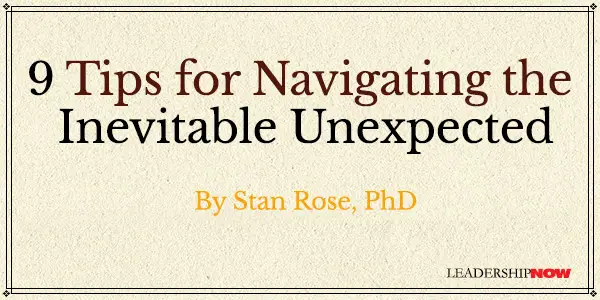
ALL COMPANIES begin with a vision. Individuals or partners develop a plan and iterate as new information arises. It takes an enormous amount of their time, forces them to commit, and requires some degree of funding. If sophisticated investors are involved — as often happens in biotech — the plan is undoubtedly subjected to intensive due diligence. Models are developed, scrutinized, and refined. Given that the global biotechnology market was valued at USD 1.55 trillion in 2023 and is projected to grow nearly 14% a year in the next 6 years, that's understandable: there's a lot at stake. All of this hard work usually involves smart people with significant experience. But that's not always enough: some 90 percent of startups do not survive past five years, and 63% of tech startups are doomed to failure. Some fail for a host of strategic or operational shortcomings addressed in any decent business school course. Others fail because no matter their degree of planning or vetting, they are unable to adequately address unexpected events in those moments of truth when they occur. I call these inevitable unexpected events — inevitable because they occur with relatively high frequency. They're things you never saw coming and you never planned for. No one can predict what they may be or when they may occur, but it's nearly guaranteed that you will encounter them. Over the course of five years, these events will occur frequently enough that your ability to address them will likely determine whether your business succeeds or fails. Any wrong move can take you down. Barriers and Opportunities These unexpected events may appear in the form of barriers to overcome, or as opportunities worthy of addressing, but you need to decide whether to do so. They are not always business issues, although they are all issues that will affect your business. I've learned that from my nearly forty years of working with scientists and clinicians to transform inventions into successful commercial products. Whether a challenge or a potential win, the common ground they share is that they will happen, they will have an impact, and how you respond will be critical to the business. No Such Thing as a Perfect Plan Can we avoid these events? Probably not: we'll encounter them no matter the breadth of our collective intelligence and experience, despite the models we develop, and regardless of the plans we base on those models. They're a humbling reminder of the incredible complexity and beauty of biology, life, and the universe we inhabit. The number of factors one would need to have considered, accounted for, and correctly predicted to have a “perfect plan” is comparable to the number of stars in the sky. This doesn’t mean we’re doomed to failure. The likelihood of making beneficial decisions when facing the unexpected increases if we routinely practice certain values, skills, and approaches. These unexpected events should not be feared but rather appreciated as opportunities to flourish and to distinguish yourself in the eyes of customers, competitors, partners, and investors. Here's a rundown of nine practices that have been particularly helpful to me when it comes to navigating life’s inevitable unexpected events:
As with any other skill set, awareness can be generated. But there will still be a spectrum of performance across individuals regarding how well they are able to apply these values and approaches to their own businesses. Certain values and approaches may not resonate as well for some as for others. My advice is not to simply store a list in your memory and pull certain items out when needed. It’s more about developing a practice, a way of conducting business (or your life). If you follow these approaches all the time, you will be as prepared as you possibly can be when it comes to confronting life’s inevitable unexpected events. The opportunities for bioentrepreneurs can be more exciting and impactful than ever in today's accelerated market. No question the biotech industry is experiencing significant growth. Navigating the unexpected has become a critical skill — and beyond biotech, these 9 tips will certainly help anyone who's pursuing a creative endeavor in any field. Build a strong foundation, cultivate a healthy respect for the unforeseen, and follow a business practice that includes proper preparation and execution, and you not only have the potential to achieve great things, you'll have a lot of fun doing so.  
Posted by Michael McKinney at 06:52 PM
03.08.24

What Is Different About Ethical Leadership?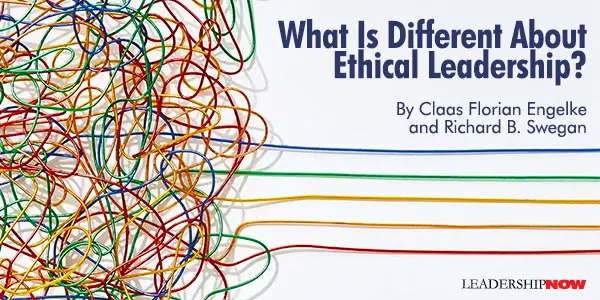
ADHERING to an ethical code during challenging times is a standout trait in many historical and present-day leaders that we’ve come to admire. Certain principals cut across the lives of such leaders as they transcend traditional leadership roles and prioritize the well-being of the communities, economies, and global society they serve. Ethical leaders embody a respect for the sanctity of each individual, regardless of culture, country, race, or religion. They have a strong orientation toward justice and fairness. While circumstances vary, their belief that everyone is entitled to the same basic dignity and rights remains a driving force for action. They have an underlying moral courage even when going against great odds. People follow them precisely because of the moral heroism they convey. Consider, for example, these leaders: Nelson Mandela – Beginning in his 20s, Mandela led a peaceful, nonviolent movement for civil rights in South Africa, for which he was imprisoned for 27 years. He was awarded a Nobel Peace Prize in 1993 for his efforts to dismantle apartheid and later became the country’s first Black president. Hamdi Ulukaya – Ulukaya immigrated to the U.S. from Turkey to escape the mistreatment of Kurds. As founder and CEO of Chobani, a top-selling yogurt company, he “operates on a simple fundamental principle, that we do well by doing good.” He has given his employees 10 percent of the company and has donated millions to fight food insecurity, while ensuring 30 percent of his workforce are immigrants and refugees. Whether leading a country, a movement, or a corporation, principled leaders act from a clear ethical foundation. They engage with issues that may not be found in a job description or easily measured by traditional metrics. At the same time, they ensure that they’re effective in delivering results. However, engaging in ethical issues is a changing realm for leaders. As witnessed by the pandemic, the world can change overnight, bringing new challenges, new dilemmas, and new choices that must be made. Keeping people safe in the broadest sense of the word becomes a foremost concern. Principled leaders must operate in a transparent and consistent manner in accordance with the values and beliefs of the organization. They need to provide sound reasons if they make choices that seemingly contradict organizational values. Clearly, ethical leadership requires a degree of introspection. An aspiring ethical leader needs to identify guiding principles and determine where to develop or reinforce existing skills — including compassion and love, trusting oneself and others, interest in others/inquisitive mindset, perseverance, and non-conforming, among other important traits. In attempting to evolve into a leader that can promote an ethics-based culture in your organization, ponder these questions: 1. What consequences may your intended decisions have for those around you? 2. In what way do the decisions you make — or the ones you avoid making — trigger consequences on a broader level (interdepartmental or across the organization)? 3. What ideas do you hold about society at a deeper level? In what way does this play into your behavior as a leader? 4. What societal, environmental, and ethical impacts does your organization have on a larger scale? 5. To what extent is your leadership team attuned to their ethical responsibilities? Is there room for improvement? 6. Assuming you can name a variety of personal values you embrace and cherish, how conscious are you of these when leading? 7. In what way do you contribute or want to contribute to the greater good? Where do you make exceptions? Why? 8. In what way do you contribute to the peaceful coexistence of individuals, teams, departments, and groups of people beyond your organization? What are you satisfied with? Where do you identify room for improvement? Overall, ethical leaders serve something greater than themselves. They have generative will — an urge and desire to create, leave a mark, improve, and serve society and establish community. What matters is the objective of a better world, a better team, a better culture, a better future.  
Posted by Michael McKinney at 09:00 AM
03.07.24

Leading Thoughts for March 7, 2024
IDEAS shared have the power to expand perspectives, change thinking, and move lives. Here are two ideas for the curious mind to engage with: Umberto Eco on leading by example: “I believe that what we become depends on what our fathers teach us at odd moments, when they aren’t trying to teach us. We are formed by little scraps of wisdom.” Source: Foucault’s Pendulum Jenifer Goldman-Wetzler on using our emotions to break our conflict habits: “Putting your emotions to work for you does not involve tamping them down, getting rid of them, or scrutinizing why you feel the way you feel. Instead, it includes identifying, acknowledging, and using your emotions as a catalyst for constructive, pattern-breaking action. You simply cannot free yourself from the conflict loop if you are unable to use your own emotions toward constructive change.” Source: Optimal Outcomes: Free Yourself from Conflict at Work, at Home, and in Life / Blog Post Look for these ideas every Thursday on the Leading Blog. Find more ideas on the LeadingThoughts index.
Posted by Michael McKinney at 11:35 AM
03.04.24

Fueling Innovation: How Microsoft Finally Got It Right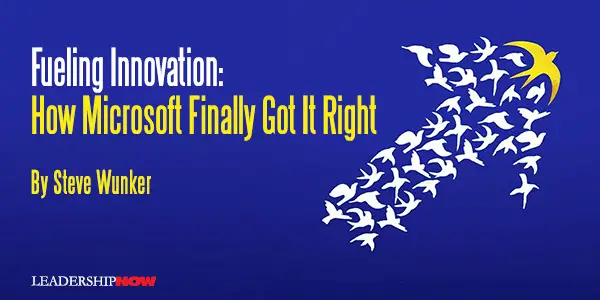
WE OFTEN THINK of innovation as something visionaries draw out of thin air, like manna from heaven. That’s a myth. Often, and especially in contemporary times, the real story of innovation doesn’t involve lone geniuses or flashes of inspiration, but teams, organizations, and leaders who cultivate systems and cultures where new ideas can sprout and flourish. Here’s an innovation story that’s closer to reality: It’s a story of loss, grit, and renewal. It’s about a wildly successful company that went off course. It’s also about a never-too-late approach to innovation that enabled a floundering business to launch a second golden age. You know this company. It has more subscribers than Netflix and Amazon combined. Its profit margin is higher than Google’s. Its market cap is over $2 trillion. Chances are, you’re one of a billion people that use its flagship software. We’re talking about Microsoft. Back in the mid-2000s, Microsoft was in trouble. Not only was the U.S. government scrutinizing it for monopolistic practices, but the company was also coming under fierce attack for investing in its archrival, Apple. Even more alarming, almost every new business it launched failed: e-books, mobile phones, search engines, music; it was one dramatic dud after another. Inside the company, morale was at an all-time low. Long-timers and new hires alike were deeply disillusioned by a caustic culture that was quick to assign blame and pitted employee against employee. With few wins in the ledger, the best and the brightest started to leave. For Microsoft, the future looked bleak. In stepped Satya Nadella. In 2014, when the company’s market capitalization was $380 billion, this Microsoft veteran took over as CEO. The turnaround he engineered was nothing short of remarkable. By 2019, Microsoft’s market capitalization edged past the $1 trillion mark, making it the world’s most valuable company. That same year, the press declared, “Microsoft is cool again.” By 2023, its market cap reached $2.5 trillion, and the company led the race for tech’s next big trophy—making artificial intelligence mainstream. How did this happen? Troubleshooting Microsoft What precisely did Nadella do to steady the company and launch it into a high-octane period of growth and innovation? Two facts underscore how he made this happen: Fact #1: Innovation Is Simply a Means to An End Nadella understood that innovation is a tool rather than a destination. His goal was not to make Microsoft the most innovative company but the most successful in its field. Of course, part of that entailed reestablishing the company’s reputation for cutting-edge technology. But there was much more than that. To him, Microsoft’s efforts lacked a strong mission. The company had been rolling out one product after another without any guiding rationale other than they were “innovative.” It was no wonder that they failed to gain traction. Innovation had become the goal, and that wasn’t enough. Nadella changed that. He quickly pivoted Microsoft from being a company that sold boxed software to a global computing engine that rents out its processing power and online storage to businesses. At the time, this was a bold suggestion. Nadella proposed that Microsoft move beyond its most profitable product, Windows, in favor of chasing a cloud dream, even though Amazon had a four-year head start. Moving into services instead of hardware also meant abandoning ambitions to compete with Apple and Google in smartphones, though Microsoft had already spent billions of dollars buying Nokia’s cellphone business. Naturally, there were many skeptics. But the decision stood. Nadella made this change in strategy clear when he announced a company-wide goal for his 115,000 employees: “We will take our tiny cloud business and build it into a multibillion-dollar empire.” This meant passing on many seductive “whiz-bang” opportunities—like autonomous vehicle hardware—and staying laser-focused on this core mission. By 2019, Nadella started shifting his aim. The company wouldn’t just be a leader in cloud, but also in AI. That year, he championed Microsoft’s first $1 billion investment into OpenAI, the company that would shake the industry with its release of ChatGPT. In 2022, he upped the ante, investing $10 billion in OpenAI to acquire just short of a majority stake. Perhaps more significantly, he also pushed each of the company’s business units to infuse AI capabilities throughout their offerings. Fact #2: Innovation Thrives in Structure To most people, this fact seems counterintuitive. Doesn’t micromanaging and process smother creativity? Innovation powerhouses don’t leave innovation up to chance. They know that innovation needs to be nurtured. You do that by setting up structures that notice, encourage, and develop innovative ideas and practices. At Microsoft, this meant fundamentally changing how people worked. It started with creating systems that captured and vetted new ideas from all over the organization. The company created “rules of the road” for what to do with a new idea: how to test it, how to build a business case for it, and who to pitch it to. Nadella championed numerous innovation programs, including allocating physical spaces for Microsoft employees to work with local entrepreneurs, creating accelerators to incubate new businesses, and hosting a global hackathon that became one of the largest innovation events in the world. From top to bottom, everyone was expected to get on board. Those who resisted—and many did at first—were often given a stern talking-to by Nadella himself. The Takeaway for Leaders and Businesses If there is one thing you take away from Microsoft’s story, let it be this: Innovation requires planning. When leaders become known as innovators—succeeding at new things again and again—they do not just “get lucky.” They plan their luck. Innovation doesn’t just show up in the middle of the night, waking you from a dream and pressing you to find a notebook by your bedside to jot down the next big idea. Innovation requires clear goals to reach toward. It demands a process to make it come to life. It’s a campaign—not a quick fix. And it’s a key skill for our 21st-century workplace.  
Posted by Michael McKinney at 09:37 AM
03.01.24

First Look: Leadership Books for March 2024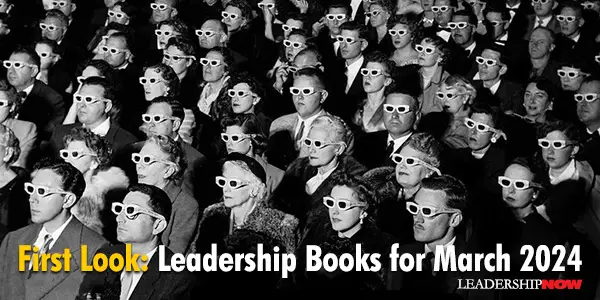
HERE'S A LOOK at some of the best leadership books to be released in March 2024 curated just for you. Be sure to check out the other great titles being offered this month.
Our current definition of “productivity” is broken. It pushes us to treat busyness as a proxy for useful effort, leading to impossibly lengthy task lists and ceaseless meetings. We’re overwhelmed by all we have to do and on the edge of burnout, left to decide between giving into soul-sapping hustle culture or rejecting ambition altogether. But are these really our only choices? From the aggressive rethinking of workload management, to introducing seasonal variation, to shifting your performance toward long-term quality, Slow Productivity provides a roadmap for escaping overload and arriving instead at a more timeless approach to pursuing meaningful accomplishment. The world of work is due for a new revolution. Slow productivity is exactly what we need.
In Think Remarkable, tech titan Guy Kawasaki teams up with Madisun Nuismer, producer of the Remarkable People podcast, to share invaluable knowledge from more than 40 years of working with game-changing organizations such as Apple, Canva, Google, Mercedes Benz, and Wikipedia, and delivers insights from a collection of amazing interviews that'll kick you into high gear and get you ready to start showing the world your best, most amazing self. Together the authors show you how to lead a fulfilling life by drawing on insights from working closely with some of the world's most remarkable people.
In Cultures of Growth, Dweck’s protégé, Mary Murphy, a social psychologist at both Stanford and Indiana University, shows that mindset transcends individuals. A growth mindset culture can transform any group, team, or classroom to reach breakthroughs while also helping each person achieve their potential. Create environments where people want to be, where everyone can thrive and achieve their potential, both individually and together. In a world where success seems reserved for a chosen few, Cultures of Growth unveils a radically different approach to creating organizations that inspire learning, growth, and success at all levels.
Leadership from Bad to Worse is about how leadership that is bad, invariably, inexorably, gets worse--unless it is somehow, by someone or something, stopped or slowed. The process of going from bad to worse tends to be steady, as opposed to hasty. But once bad burrows in, it digs in. It digs in deeper and then deeper, making it difficult finally to extract or excise without getting rid of whoever and whatever is involved. Bad leadership is a social disease. But unlike diseases that are physical or psychological, it remains at the margins of our collective concerns. Leadership from Bad to Worse is, then, a corrective. Knowing that bad leadership can be checked before it corrupts is knowing that bad and then worse can be, if not completely precluded, then sometimes short-circuited.
People love to keep score. Managers keep score of a range of business metrics: market share, revenue, profit margin, growth rate. In our personal lives, social media has us keeping score by likes and followers. Offering both descriptive and prescriptive advice and anecdotes, The Score That Matters will help you unlock true fulfillment and happiness by discovering your purpose, identifying your values, and creating critical behaviors and living them faithfully every day in all aspects of your life.
Entrepreneurs often have a burning need to succeed. But that same relentless brilliance that propels you in your career can take a toll on your teams, personal relationships, and even your health. Gino Wickman, bestselling author of Traction, teams up with mindfulness expert Rob Dube to help readers strike a crucial balance between those inner and outer worlds while taking your success to new heights. In Shine, they share 10 disciplines to help you stay sharp and energetic without burning out. You’ll learn to: Set boundaries in your work life (without compromising productivity) that allow you to become a better leader and better person; Practicable sustainable ways to reset your energy and recognize burnout and stress before they happen; Tap into a flow state to harness unbridled creativity, think clearly, and move through your career and life with ease.
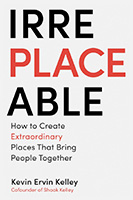 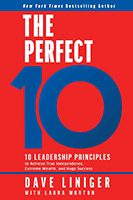 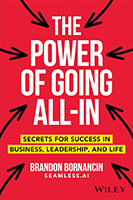 
“... a mind needs books as a sword needs a whetstone, if it is to keep its edge.” — George R.R. Martin, A Game of Thrones
Posted by Michael McKinney at 09:34 AM
|
BUILD YOUR KNOWLEDGE


How to Do Your Start-Up Right STRAIGHT TALK FOR START-UPS 
Grow Your Leadership Skills NEW AND UPCOMING LEADERSHIP BOOKS 
Leadership Minute BITE-SIZE CONCEPTS YOU CAN CHEW ON 
Classic Leadership Books BOOKS TO READ BEFORE YOU LEAD |
|